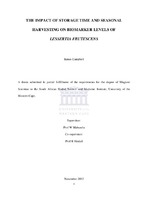| dc.description.abstract | In South Africa, it is estimated that approximately 70% of the population frequently make use of traditional medicinal plants for their health care needs. The use of Lessertia frutescens by the various cultural groups in South Africa dates back to the earlier civilizations and continues to be used today to treat a multitude of ailments. To get the best results from a medicinal plant, one would need to ensure that the crude material is of good quality through interventions like being properly grown, well dried and correctly processed. This would add a measure of quality assurance, which will contribute towards the safety and efficacy aspect
of herbal medicine. The aim of this study was to investigate what impact a particular season of harvest and the time in storage would have on the flavonoid and triterpenoid marker levels of Lessertia frutescens. To achieve this, the following was investigated: (1) storage variation of Lessertia frutescens leaves by comparing the results obtained from the High Performance Liquid Chromatography (HPLC) analysis of the flavonoids and triterpenoids, (2) seasonal variation of Lessertia frutescens leaves by comparing the results obtained from the HPLC analysis of the flavonoids and triterpenoids, (3) leaf and stem variation of Lessertia frutescens by comparing the results obtained from HPLC analysis of the flavonoids and triterpenoids. The hypotheses were: (1) the stored sample would indicate the same level of the biomarkers for the flavonoids and triterpenoids, as that of the freshly prepared sample, (2) the sample that was harvested during the summer season would indicate higher levels of the biomarkers of flavonoids and triterpenoids than the other three seasons, (3) the leaf sample would indicate
the same level of the biomarkers for the flavonoids and triterpenoids, as that of the stem sample. An Agilent 1200 series HPLC was used for the determination of the flavonoids sutherlandin A and sutherlandin D as well as the triterpenoids sutherlandioside B and sutherlandioside D. Results show that for both sutherlandin A (summer: 3.67 ± 2.88 mg/ml; storage: 4.07 ± 2.88 mg/ml) and D (summer: 4.10 ± 1.06 mg/ml; storage: 4.25 ± 1.06 mg/ml) show significantly (P < 0.0001) higher concentrations in the case of the storage samples. For both sutherlandioside B (summer: 3.01 ± 0.39 mg/ml; storage: 2.82 ± 0.39 mg/ml) and D (summer: 5.82 ± 0.42 mg/ml; storage: 4.66 ± 0.42 mg/ml) show significantly (P < 0.0001)
higher concentrations in the case of the fresh summer samples. For the seasonal comparison, results show that for sutherlandin A (summer: 3.67 ± 12.49 mg/ml; autumn: 4.75 ± 12.49 mg/ml; winter: 4.23 ± 12.49 mg/ml; spring: 6.56 ± 12.49 mg/ml) show significantly (P < 0.0001) higher concentrations in the case of the spring sample. For sutherlandin D (summer: 4.10 ± 10.32 mg/ml; autumn: 6.37 ± 10.32 mg/ml; winter: 5.25 ± 10.32 mg/ml; spring; 6.08 ± 10.32 mg/ml) show
significantly (P < 0.0001) higher concentrations in the case of the autumn sample. For both sutherlandioside B (summer: 3.01 ± 7.19 mg/ml; autumn: 2.15 ± 7.19 mg/ml; winter: 2.89 ± 7.19 mg/ml; spring: 1.47 ± 7.19 mg/ml) and D (summer: 5.82 ± 14.48 mg/ml; autumn: 3.33 ± 14.48 mg/ml; winter: 4.23 ± 14.48 mg/ml; spring: 2.50 ± 14.48 mg/ml) show significantly (P < 0.0001) higher concentrations in the case of the autumn sample. For the summer leaf/stem comparison, results show that for sutherlandin A (leaf: 3.67 ± 8.18 mg/ml; stem: 4.67 ± 8.18 mg/ml) show significantly (P < 0.0001) higher concentrations in the case of the stem sample. For the sutherlandin D (leaf: 4.10 ± 4.81 mg/ml; stem: 3.31 ± 4.81
mg/ml) show significantly (P < 0.0001) higher concentrations in the case of the summer leaf sample. For both the sutherlandioside B (leaf: 3.01 ± 4.24 mg/ml; stem: 3.62 ± 4.24 mg/ml) and D (leaf: 5.82 ± 0.42 mg/ml; stem: 5.80 ± 0.42 mg/ml) show significantly (P < 0.0001) higher concentrations in the case of the stem samples.Results demonstrate that the production of secondary metabolites are influenced by environmental factors like seasonal harvesting, as indicated by the variation in the chemical constituent composition of Lessertia frutescens depending on the season collected in. Moreover, the storage of Lessertia frutescens for a period of one year resulted in an increase of two of the four constituents being monitored. There was slight variations in the chemical constituents, depending on whether the leaf or stem material of Lessertia frutescens was
being used. Finally, the type of chemical constituent being monitored was also important in the consideration of this study. Therefore, this study can be seen as a starting point to further investigations of these aspects, which are of clinical, pharmacological and economic importance. | en_US |

